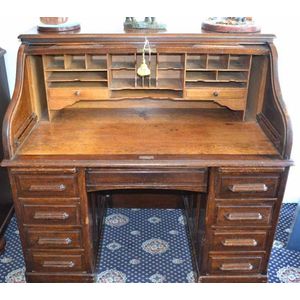Bronze Owl Sculpture on Stand
You must be a subscriber, and be logged in to view price and dealer details.
Subscribe Now to view actual auction price for this item
When you subscribe, you have the option of setting the currency in which to display prices to $Au, $US, $NZ or Stg.
- Bronze - An alloy of copper and tin, traditionally in the proportions of about 9 parts of copper to 1 part of tin.
The discovery of bronze in Western Asia in the 4th century enabled people to create metal objects which were superior to those previoulsy possible because of its strength and hardness, and it has been used throughout the world for weapons, coins, tools, statuary and other decorative items.
It is very fluid in a molten state, and its hardness, strength when set, and non-corrosive properties makes it most suitable for casting sculpture. - Hollow Cast - Hollow casting is a metalworking process used to create hollow objects such as sculptures, jewelry, and other decorative objects. It involves casting metal in a mould that has a cavity in the shape of the desired object.
The process of hollow casting has been used for centuries, and its invention is not attributed to a single individual. However, ancient civilizations such as the Egyptians and Greeks used this process to create metal objects. In modern times, hollow casting has been used by artists, jewellers, and manufacturers to create a wide range of objects.
The first step in hollow casting is to create a model of the object to be cast from materials such as clay, wax, or metal, and from this a mould is created around it using a material such as plaster, silicone, or rubber. A core is created inside the mold to create the hollow cavity of the final object and then molten metal is poured into the mould, filling the space around the core. The metal is then allowed to cool and harden.
Once the metal has cooled and hardened, the core is removed from the mold, leaving a hollow object which is then finished by removing any excess metal or imperfections and polishing or texturing the surface as desired.
Hollow casting is used to create a wide variety of objects, including sculptures, jewellery, decorative objects, and parts for machinery. The process allows for the creation of complex shapes and details, and can be used with a wide range of metals, including bronze, brass, silver, and gold. Hollow casting is also used in manufacturing to create components such as engine blocks and machine parts.
This item has been included into following indexes:
Visually similar items

An Australian Colonial cedar chest of drawers, c.1880's, the upper chest with two central half size drawers, flanked by two deep size drawers, over three lower full size drawers with turned knob handles. Height 114 cm. Width 105 cm. Depth 45 cm

An Edwardian oak, roll top action, Cutler style desk, early 20th century. the desk has a roll-top sliding door action with interior drawers and stationery compartments. the base has twin pedestal drawers with pull out writing shelves, with makers label Ang

An 18ct gold garnet and diamond stone bridge ring

Victorian watch key with carnelian and bloodstone
